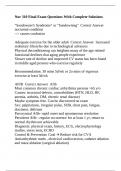Nur 310 Final Exam Questions With Complete Solutions
"Sundowner's Syndrome" or "Sundowning" Correct Answer
nocturnal condition
--> causes confusion
Adequate exercise for the older adult Correct Answer Increased
sedentary lifestyles due to technological advances
Physical deconditioning can heighten many of the age related
functional declines that aging people experience
Slower rate of decline and improved CV status has been found
in middle aged persons who exercise regularly
Recommendation: 30 mins 5d/wk or 2o mins of vigorous
exercise at least 3d/wk
AFIB Correct Answer Afib
Most common chronic cardiac arrhythmia persons >65 y/o
Causes: structural defects, comorbidities (HTN, HLD, HF,
anemia, arthritis, DM, chronic renal disease)
Maybe symptom free. Can be discovered on exam
Sxs: palpitations, irregular pulse, SOB, chest pain, fatigue,
dizziness, delirium
Paroxysmal Afib- rapid onset and spontaneous resolution
Persistent Afib - regular occurrence for at least 1 yr, return to
normal rhythm not achievable
Diagnosis: physical exam, history, ECG, electrophysiology
studies, stress tests, ECHO
Control & Prevention: Goal 🡪 Reduce risk for CVA
Antiarrhythmic meds , electrical cardioversion, catheter ablation
and maze ablation (surgical ablation)
,Nursing education 🡪 disease, treatments, diet, activities,
symptoms to report promptly (palpitations, edema, wt gain,
SOB, fatigue, signs of bleeding)
Agnosia meaning Correct Answer unable to recognize familiar
objects, tasks, sounds
--> (picks up a pen when you asked for an apple)
Alzheimer's Disease (Sub-type dementia) Correct Answer
characterized by 2 changes
-Neuritic plaques (deposits of B-amyloid protein) ; unclear if
cause or by-product of disease
-Neurofibrillary tangles (tau) in athe cortex
Amnesia meaning Correct Answer memory loss (memory
eraser)
Aneurysms Correct Answer Can develop in peripheral arteries
🡪 most common: popliteal & femoral
Most serious complication 🡪 formation of a thrombus which
can occlude vessel & cause loss of limb
Abdominal aortic aneurysms 🡪 early treatment reduces risk of
complications and death, can be resected, portion of vessel
removed and replaced with prosthetic material
Lumbar sympathectomy can be performed
Prevent thrombus post-operatively
Angina Correct Answer Atypical pattern in older adults
Pain: diffuse, less severe nature than in younger adults
,Vague discomfort under the sternum, frequently after a large
meal 🡪 may be confused with indigestion
As condition progresses, the patient my experience precordial
pain radiating down the left arm
Other symptoms: coughing, syncope, sweating with exertion,
and episodes of confusion
Anomia meaning Correct Answer Unable to remember the
name of things
(what is that called?)
Aphasia meaning Correct Answer Unable to speak or express
oneself; may not understand spoken, written, or sign language
Apraxia meaning Correct Answer Unable to do movements
-decline in ADL's
(dressing)
Arteriosclerosis Correct Answer --common among older
persons (especially with DM)
--unlike atherosclerosis which generally affects large vessels
coming from the heart, arteriosclerosis affects smaller vessels
farthest from the heart
Diagnosis:
Arteriography and Radiography
Oscillometric testing can assess arterial pulse at diff levels 🡪
keep pt warm for at least 1 hr prior to test if surface temp is
evaluated as a diagnostic measure
Treatment:
, Bed rest, warmth, Buerger-Allen test (Box 17-6) and
vasodilators
Sympathetic ganglionectomy can occasionally achieve
permanent vasodilation
Special Problems Associated with DM:
DM associated neuropathies and infections affect vessels
throughout body
Arterial insufficiency can present: Resting pain d/t intermittent
claudication, Arterial pulses difficult to find or absent, Skin
Discoloration, Ulcerations, Gangrene
Assessment for incontinence Correct Answer Medical history:
Note diagnoses that could contribute to incontinence, such as
delirium, dementia, cerebrovascular accident, diabetes mellitus,
congestive heart failure, UTI.
Medications: Review all prescription and nonprescription drugs
used for those that can affect continence, such as diuretics,
antianxiety agents, antipsychotics, antidepressants, sedatives,
narcotics, antiparkinsonian agents, antispasmodics,
antihistamines, calcium channel blockers, and alpha-blockers
and alpha-stimulants.
Functional status: Assess activities of daily living; note
impairments; ask about recent changes in function; determine
degree of dependency on others for mobility, transfers, toileting.
Cognition: Test cognitive function; review symptoms such as
depression, hallucinations; ask about recent changes in mood or
intellectual function.




